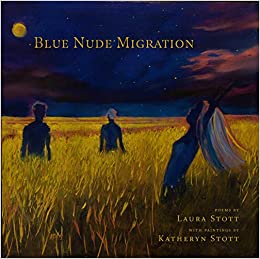 Guest post by Laura Stott
Guest post by Laura Stott
Come quickly. You mustn’t miss the dawn. It will never be just like this again.
-Georgia O’Keeffe
Would not it be best to leave room to mystery?
-Henri Matisse
My mother is an artist and her favorite artist is Pablo Picasso. So, growing up there were no limits or restraints on what I was told was possible on the page.
My new book, Blue Nude Migration (Lynx House Press, 2020), is an ekphrastic collection responding to various artists, but most directly the blue nude cutouts of Henri Matisse. The book also has full color images of 17 paintings 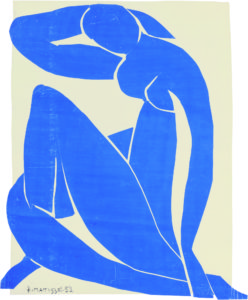 by my sister, Katheryn Stott Buxton in conversation with the poems throughout. A bit about Matisse: he worked on his blue nudes when he was too sick with cancer to paint, so he painted large sheets of paper blue, cut out different shapes for the human form, cut and rearranged, and cut and rearranged some more until he was satisfied with the final nudes. Just search Blue Nude Cutouts by Henri Matisse on the internet and you’ll see what I mean, and chances are, you’ve seen them before. They are abstract, blue, and powerful. I’ve always been drawn to the figure in visual art. In my own dabbling with drawing and painting, it was always flowers or people. At any rate, in the blue nude poems I wrote, the blue nudes took on a life of their own, left the page, and started wandering around the U.S., leaving us for the desert, getting lost in Alaska, or soaking up sun in Los Angeles. In the beginning of this process, I was also thinking about the women who sat for these artists and who they were as real people and not just a finished painting. But I was also focused on Matisse’s nudes and envisioning their abstract nakedness in our normal and abnormal moments of life. The nudes
by my sister, Katheryn Stott Buxton in conversation with the poems throughout. A bit about Matisse: he worked on his blue nudes when he was too sick with cancer to paint, so he painted large sheets of paper blue, cut out different shapes for the human form, cut and rearranged, and cut and rearranged some more until he was satisfied with the final nudes. Just search Blue Nude Cutouts by Henri Matisse on the internet and you’ll see what I mean, and chances are, you’ve seen them before. They are abstract, blue, and powerful. I’ve always been drawn to the figure in visual art. In my own dabbling with drawing and painting, it was always flowers or people. At any rate, in the blue nude poems I wrote, the blue nudes took on a life of their own, left the page, and started wandering around the U.S., leaving us for the desert, getting lost in Alaska, or soaking up sun in Los Angeles. In the beginning of this process, I was also thinking about the women who sat for these artists and who they were as real people and not just a finished painting. But I was also focused on Matisse’s nudes and envisioning their abstract nakedness in our normal and abnormal moments of life. The nudes 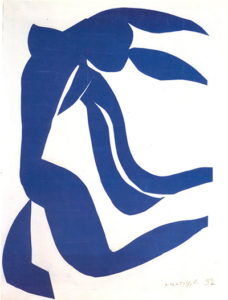 became and represented figures that exist between one world and somewhere else. They are surreal, strange, and all shades of blue. The joy and the suffering. If I were to describe my poetry, I would say that is something I like to do—keep one foot grounded in this world, the natural world, and one foot in some other realm. I suppose I may be describing magical realism, but I’m not sure I consider it that. Though when you grow up religious, and I still am, I think it is easy to have a propensity for the surreal and the magical. The spiritual cultivates that. At least I think so.
became and represented figures that exist between one world and somewhere else. They are surreal, strange, and all shades of blue. The joy and the suffering. If I were to describe my poetry, I would say that is something I like to do—keep one foot grounded in this world, the natural world, and one foot in some other realm. I suppose I may be describing magical realism, but I’m not sure I consider it that. Though when you grow up religious, and I still am, I think it is easy to have a propensity for the surreal and the magical. The spiritual cultivates that. At least I think so.
When I showed these poems to my sister, Katheryn, we decided to do a collaboration and she painted a series of paintings of blue nudes in conversation with the poems. We had a show at the Ragged Edge in Gettysburg, Pennsylvania of the paintings and poems, and another one at the Foothill-Branch Library in Salt Lake City. I love how art begets art and this project shows the birth of poems from art and then more art from that. My sister’s paintings are beautiful. I love the intensity of color in them. And I am so pleased that we found a publisher willing to print the paintings inside the book in full color throughout. It had to be that way. If you get a chance, look her up: https://katherynstottbuxton.com/
Some thoughts I have about poetry:
1) Writing poems is an act of faith. Faith without works is dead and poems don’t happen all by themselves. You have to work at them. And I never know how a poem is going to end or what is going to happen next, what kind of metaphor or image will pop in while I’m writing the poem before I’m writing it. But I move forward, like faith, and it is a delight to see what comes onto the page. And I recognize that this kind of trust, that something will happen takes practice, just like in life. And you know, I don’t love all my poems. But you have to write a lot to get the ones you love.
2) Poetry can help us find joy. It is that increased empathy we receive from reading poems, from writing them, and the attention to detail that it brings. When we zoom in or out and look at the details of our experiences, or of others, this increases gratitude and our joy.
3) Poetry can also change us. I believe every time we encounter art we are changed even if only incrementally, in the tiniest of ways, we may not even know it happened. But sometimes an encounter with art can change us in a big way. And this is true of writing poems as well. I believe I’m a different person after writing a poem than I was before I wrote it. I heard Ellen Bass talk about this once, and I knew it was true when I heard it. The process of writing is discovery, it’s revelation, it teaches us things about the world around us and about ourselves. Poems show us possibilities. I like that poems can change us and take us anywhere.
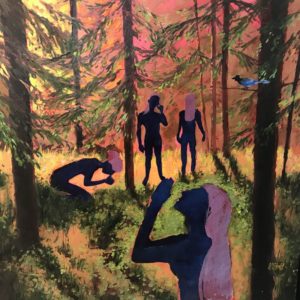 Below is the poem titled “Absence” out of Blue Nude Migration that correlates directly with the cover art for the book. I’ve also included another painting here by my sister Katheryn; in the book, it’s in conversation with the poem, “This is What Didn’t Happen.” Just a sneak peak of what’s inside.
Below is the poem titled “Absence” out of Blue Nude Migration that correlates directly with the cover art for the book. I’ve also included another painting here by my sister Katheryn; in the book, it’s in conversation with the poem, “This is What Didn’t Happen.” Just a sneak peak of what’s inside.
Thanks for reading!
Absence
Blue nudes hide
in the wheat fields, all that rolling
green. During the day, occasionally,
you’ll see a body stand waist
deep, or a head lift up from the swaying,
feathery tops of grain–
they lie down in it and believe
their secret’s kept.
Watch
from the corner of your eyes—at night,
they come out. They stand
and see no one
and continue walking
with their hands palms down,
the young wheat barely
touching that skin.
The moon is a sliver
hiding in blackness above them,
the stars falling
clockwise
as their bare feet turn slightly
in the same direction until
they remember that north star and perfect ladle
offering
anyone a sip of universe,
if they will take it.
-From Blue Nude Migration, published by Lynx House Press
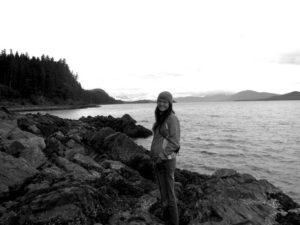 Laura Stott is author of In the Museum of Coming and Going (2014 AML Poetry Award finalist); her poems have also appeared in Western Humanities Review, the Aurorean, Sugar House Review, Rock and Sling, Copper Nickel, Memorious, and Cutbank. She teaches at Weber State University in Ogden, Utah. Artist Katheryn Stott Buxton received a BFA at Brigham Young University and currently resides in Provo, Utah.
Laura Stott is author of In the Museum of Coming and Going (2014 AML Poetry Award finalist); her poems have also appeared in Western Humanities Review, the Aurorean, Sugar House Review, Rock and Sling, Copper Nickel, Memorious, and Cutbank. She teaches at Weber State University in Ogden, Utah. Artist Katheryn Stott Buxton received a BFA at Brigham Young University and currently resides in Provo, Utah.
You can read a review of the 2018 poetry and art show, with more images, here.

.
Exciting to see such a fresh project.